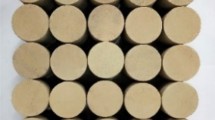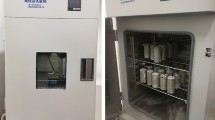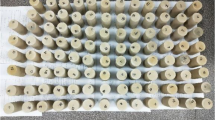Abstract
To study rock damage characteristics under long-term freeze-thaw cycles and loads, rock freeze-thaw and creep damage factors were defined based on nuclear magnetic resonance porosity and volume strain, respectively. The damage factor is introduced into the basic rheological element, and the non-linear creep damage constitutive model and freeze-thaw rock equation are established to describe non-linear creep characteristics under a constant load. Simultaneously, the creep test of freeze-thaw rock under step loading is performed. Based on the test data, the applicability and accuracy of the creep damage freeze-thaw rock model are analyzed and verified. The results show that freeze-thaw cycles result in continuous rock pore structure damage and deterioration, and nuclear magnetic resonance porosity enhancement. The constant load induces increasing rock plastic deformation, volume, and creep aging damage. As the loading stress increases, the instantaneous rock elastic parameters increase, and the rheological elastic and viscosity parameters decrease. Furthermore, the damage degradation of freeze-thaw cycles weakens the rock viscoplasticity, resulting in a rapid decrease in the viscosity parameter with an increase in freeze-thaw cycles. Generally, the continuous damage of the rock is degraded, and the long-term strength decreases continuously.
摘要
为了研究冻融循环与载荷的长期作用下岩石内部的损伤特性, 以流变理论、损伤力学为基础, 定义了基于核磁共振孔隙度的岩石冻融损伤因子与基于体应变的蠕变损伤因子, 并将损伤因子引入基本流变元件中, 建立了冻融岩石的非线性蠕变损伤本构模型与方程, 用以描述冻融岩石在恒定载荷下的非线性蠕变特征。同时, 开展了冻融岩石的分级加载蠕变试验, 获得了冻融循环前后核磁共振孔隙度与岩石横向应变、纵向应变的变化情况。以试验数据为基础, 分析并验证了冻融岩石蠕变损伤模型的适用性与准确性。结果表明, 在冻融循环的作用下, 岩石内部孔隙结构不断损伤劣化, 核磁共振孔隙度持续增加; 在恒定载荷的作用下, 岩石的塑性变形增加, 体积增长明显, 蠕变时效损伤增强。随着加载应力的增加, 岩石的瞬时弹性参数增大, 流变弹性参数、黏性参数在快速降低; 其中高应力水平对岩石具有硬化作用从而减弱部分损伤效应, 使得后期流变弹性参数在小范围波动, 而冻融循环的损伤劣化作用, 使得岩石的黏塑性减弱, 导致黏性系数随着冻融次数的增加而快速降低, 但总体上岩石不断的损伤劣化, 长期强度持续降低。本文建立的基于损伤因子的冻融岩石蠕变模型, 能够准确描述冻融岩石的非线性特征。
Similar content being viewed by others
References
MU Yan-hu, MA Wei, NIU Fu-jun, LIU Ge, ZHANG Qing-long. Study on geotechnical hazards to roadway engineering in permafrost regions [J]. Journal of Disaster Prevention and Mitigation Engineering, 2014, 34(3): 259–267. DOI: https://doi.org/10.13409/j.cnki.jdpme.2014.03.005. (in Chinese)
LUI Hui, YANG Geng-she, JIA Hai-liang, YE Wan-jun, WEI Yao, XI Jia-mi, SHEN Yan-jun, ZHANG Hui-mei. Experimental study on meso-structure of rock in the process of crack (pore) water freezing [J]. Chinese Journal of Rock Mechanics and Engineering, 2016, 35(12): 2516–2524. DOI: https://doi.org/10.13722/j.cnki.jrme.2016.0906. (in Chinese)
AL-OMARI A, BECK K, BRUNETAUD X, AKOS T, MUKHTAR A. Critical degree of saturation: A control factor of freeze-thaw damage of porous limestones at Castle of Chambord, France [J]. Engineering Geology, 2015, 185(3): 71–80. DOI: https://doi.org/10.1016/j.enggeo.2014.11.018.
KHANLARI G, SAHAMIEH R Z, ABDILOR Y. The effect of freeze-thaw cycles on physical and mechanical properties of upper red formation sandstones, central part of Iran [J]. Arabian Journal of Geosciences, 2015, 8(8): 5991–6001. DOI: https://doi.org/10.1007/s12517-014-1653-y.
FENG Fan, LI Xi-bing, JAMAL Rostami, PENG Ding-xiao, LI Di-yuan, DU Kun. Numerical investigation of hard rock strength and fracturing under polyaxial compression based on Mogi-Coulomb failure criterion [J]. International Journal of Geomechanics, 2019, 19(4): 04019005. DOI: https://doi.org/10.1061/(ASCE)GM.1943-5622.0001352.
CHEN Wei-zhong, TAN Xian-jun, YU Hong-dan, YUAN Ke-kuo, LI Shu-cai. Advance and review on thermo-hydromechanical characteristics of rock mass under condition of low temperature and freeze-thaw cycles [J]. Chinese Journal of Rock Mechanics and Engineering, 2011, 30(7): 1318–1336. (in Chinese)
HUANG Shi-bing, LIU Quan-sheng, CHENG Ai-ping, LIU Yan-zhang. A statistical damage constitutive model under freeze-thaw and loading for rock and its engineering application [J]. Cold Regions Science and Technology, 2018, 145(1): 142–150. DOI: https://doi.org/10.1016/j.coldregions.2017.10.015.
DAVID G. Creep of rocks [J]. The Journal of Geology, 1939, 47(3): 225–251.
FU Bing-jun. Academician Chen Zongji’s life [J]. Progress in Rock Mechanics and Engineering, 2002, 8(3): 1–9.
TOSHIHISA A, AKIO T. Prediction of long term strength of soft sedimentary rock [C]//Proceedings of the International Symposium on Weak Rock, Tokyo, 1981: 99–104.
ZHAO Bao-yun, LIU Dong-yan, ZHENG Ying-ren, LIU Hong. Uniaxial compressive creep test of red sandstone and its constitutive model [J]. Journal of Mining & Safety Engineering, 2013, 30(5): 744–747. (in Chinese)
ZHAO Yan-lin, ZHANG Lian-yang, WANG Wei-jun, WAN Wen, LI Shu-qing, MA Wen-hao, WANG Yi-xian. Creep behavior of intact and cracked limestone under multi-level loading and unloading cycles [J]. Rock Mechanics and Rock Engineering, 2017, 50(6): 1–16. DOI: https://doi.org/10.1007/s00603-017-1187-1.
LI Bing. Research on creep properties and damage rupture mechanism of concrete under freeze-thaw effect [D]. Xuzhou: China University of Mining and Technology, 2016. (in Chinese)
KARACA Z, DELIORMANLI A H, ELCI H, PAMUKCU C. Effect of freeze-thaw process on the abrasion loss value of stones [J]. International Journal of Rock Mechanics & Mining Sciences, 2010, 47(7): 1207–1211. DOI: https://doi.org/10.1016/j.ijrmms.2010.07.003.
ZHOU Zhi-wei, MA Wei, ZHANG Shu-juan, MU Yan-hu, LI Guo-yu. Effect of freeze-thaw cycles in mechanical behaviors of frozen loess [J]. Cold Regions Science and Technology, 2018, 146(2): 9–18. DOI: https://doi.org/10.1016/j.coldregions.2017.11.011.
WEI Li-de, YANG Chun-he, XU Wei-ya. Study on creep damage constitutive model of salt rock based on mesomechanics [J]. Chinese Journal of Rock Mechanics and Engineering, 2005, 24(23): 4253–4258. (in Chinese)
XIA Cai-chu, JIN Lei, GUO Rui. Nonlinear theoretical rheological model for rock: A review and some problems [J]. Chinese Journal of Rock Mechanics and Engineering, 2011, 30(3): 454–463. (in Chinese)
LU Ya-ni, LI Xin-ping, CHAN A. Damage constitutive model of single flaw sandstone under freeze-thaw and load [J]. Cold Regions Science and Technology, 2019, 159: 20–28. DOI: https://doi.org/10.1016/j.coldregions.2018.11.017.
KANG Yong-gang, ZHANG Xiu-e. An improved constitutive model for rock creep [J]. Rock and Soil Mechanics, 2014, 35(4): 1049–1055. DOI: https://doi.org/10.16285/j.rsm.2014.04.011. (in Chinese)
PU Cheng-zhi, CAO Ping, ZHANG Chun-yang, ZHANG Qiu-cai. Variable parameters nonlinear creep damage model of rock with consideration of aging, damage and deterioration [J]. Engineering Mechanics, 2017, 34(6): 17–27. (in Chinese)
SHEN Cai-hua, ZHANG Bing, WANG Wen-wu. A new visco-elastoplastic creep constitutive model based on strain energy theory [J]. Rock and Soil Mechanics, 2014, 5(12): 3430–3436. DOI: https://doi.org/10.16285/j.rsm.2014.12.016. (in Chinese)
CHEN Yuan-jiang, PAN Chang-liang, CAO Ping, WANG Wen-xing. Endochronic rheological constitutive model of soft rock [J]. The Chinese Journal of Nonferrous Metals, 2003, 13(3): 735–742. DOI: https://doi.org/10.19476/j.ysxb.1004.0609.2003.03.041. (in Chinese)
MOMENI A, ABDILOR Y, KHANLARI G R, HEIDARI M, SEPAHI A A. The effect of freeze-thaw cycles on physical and mechanical properties of granitoid hard rocks [J]. Bulletin of Engineering Geology and the Environment, 2016, 75(4): 1649–1656. DOI: https://doi.org/10.1007/s10064-015-0787-9.
LI Jie-lin, ZHOU Ke-ping, ZHANG Ya-min, XU Yu-juan. Experimental study of rock porous structure damage characteristics under condition of freezing-thawing cycles based on nuclear magnetic resonance technique [J]. Chinese Journal of Rock Mechanics and Engineering, 2012, 31(6): 1208–1214.
HACHIMI D, NAIMA B, ABDELDJALIL Z. Modeling of creep behavior of an argillaceous rock by numerical homogenization method [J]. Periodica Polytechnica Civil Engineering, 2018, 62(2): 462–469. DOI: https://doi.org/10.3311/PPci.11697.
BIKONG C, HOXHA D, SHAO J F. A micro-macro model for time-dependent behavior of clayey rocks due to anisotropic propagation of microcracks [J]. International Journal of Plasticity, 2015, 69: 73–88. DOI: https://doi.org/10.1016/j.ijplas.2015.02.001.
XU Hong-fa. Time dependent behaviours of strength and elasticity modulus of weak rock [J]. Chinese Journal of Rock Mechanics and Engineering, 1997, 16(3): 245–251. (in Chinese)
XU Tao, TANG Chun-an, ZHAO Jian, LI Lian-chong, HEAP M J. Modelling the time- dependent rheological behaviour of heterogeneous brittle rocks [J]. Geophysical Journal International, 2012, 189(3): 1781–1796. DOI: https://doi.org/10.1111/j.1365-246X.2012.05460.x. (in Chinese)
YANG Zhen-wei, JIN Ai-bing, GAO Yong-tao, WANG Kai, SUN Hao. Non-stationary Nishihara model in the particle flow code [J]. Chinese Journal of Engineering, 2015, 37(7): 831–838. DOI: https://doi.org/10.13374/j.issn2095-9389.2015.07.002. (in Chinese)
HUANG Shi-bing, LIU Quan-sheng, CHENG Ai-ping, LIU Yan-zhang, LIU Guo-feng. A fully coupled thermo-hydromechanical model including the determination of coupling parameters for freezing rock [J]. International Journal of Rock Mechanics and Mining Sciences, 2018, 103: 205–214. DOI: https://doi.org/10.1016/j.ijrmms.2018.01.029.
JIA Hai-liang. Theoretical damage models of porous rocks and hard jointed rocks subjected to frost action and further experimental verifications [D]. Wuhan: China University of Geosciences, 2016. (in Chinese)
XU Qiang, LU Zhong-yu, WANG Xue. Damage modelling: The current state and the latest progress on the development of creep damage constitutive equations for high Cr steels [J]. Materials at High Temperatures, 2017, 34(3): 229–237. DOI: https://doi.org/10.1080/09603409.2017.1289613. (in Chinese)
KONG Xiang-yan. Isopercolation mechanics of pupils [M]. Hefei: China University of Science and Technology Press, 1999. (in Chinese)
KE Bo, ZHOU Ke-ping, XU Chao-shui, DENG Hong-wei, LI Jie-lin, Bin Feng. Dynamic mechanical property deterioration model of sandstone caused by Freeze-thaw weathering [J]. Rock Mechanics and Rock Engineering, 2018, 51(9): 2791–2804. DOI: https://doi.org/10.1007/s00603-018-1495-0. (in Chinese)
WEI Li-de, YANG Chun-he, XU Wei-ya. A damage constitutive model for rock with plastic volume strain [J]. Engineering Mechanics, 2006, 23(1): 139–143. (in Chinese)
LÜ Jian-guo, WANG Zhi-qiao, LIU Hong-yan. Rock fracture and damage [M]. Beijing: Geological Publishing House, 2013. (in Chinese)
YUAN Xiao-qing, LIU Hong-yan, LIU Jing-ping. A damaging model of jointed rock under coupled action of freezing and thawing [J]. Chinese Journal of Rock Mechanics and Engineering, 2015, 34(8): 1602–1611. DOI: https://doi.org/10.13722/j.cnki.jrme.2014.1342. (in Chinese)
ZHANG Hui-mei, YANG Geng-she. Research on damage model of rock under coupling action of freeze-thaw and load [J]. Chinese Journal of Rock Mechanics and Engineering, 2010, 29(3): 471–476. (in Chinese)
BOURAS Y, DUSAN Z, TEODOR M A, ZORA V. A non-linear thermo-viscoelastic rheological model based on fractional derivatives for high temperature creep in concrete [J]. Applied Mathematical Modelling, 2018, 55: 551–568. DOI: https://doi.org/10.1016/j.apm.2017.11.028.
XIA Cai-chu, JIN Lei, GUO Rui. Nonlinear theoretical rheological model for rock: A review and some problems [J] Chinese Journal of Rock Mechanics and Engineering, 2011, 30(3): 454–463. (in Chinese)
SHAO Jian-fu, ZHU Qi-zhi, SU K. Modeling of creep in rock materials in terms of material degradation [J]. Computers and Geotechnics, 2003, 30(7): 549–555. DOI: https://doi.org/10.1016/S0266-352X(03)00063-6.
XU Wei-ya, YANG Sheng-qi, CHU Wei-jiang. Nonlinear viscoelasto-plastic rheological model (hohal model) of rock and its engineering application [J]. Chinese Journal of Rock Mechanics and Engineering, 2007, 26(3): 433–447. (in Chinese)
SONG Yong-jun, LEI Sheng-you, LIU Xiang-ke. Non-linear rock creep model based on hardening and damage effect [J]. Journal of China Coal Society, 2012, 37(S2): 287–292. (in Chinese)
Author information
Authors and Affiliations
Corresponding authors
Additional information
Foundation item
Projects(41502327, 51474252, 51774323) supported by the National Natural Science Foundation of China; Project(2020JJ4712) supported by the Natural Science Foundation of Hunan Province, China; Project(CX20190221) supported by the Hunan Provincial Innovation Foundation for Postgraduate, China; Project(ZJRMG-2018-Z03) supported by the Key Laboratory of Rock Mechanics and Geohazards of Zhejiang Province, China
Contributors
ZHU Long-yin provided the concept and edited the first draft of manuscript. LI Jie-lin conducted the literature review. ZHOU Ke-ping edited the draft of manuscript. CHEN Hui developed the overarching research goals. LIN Yun analyzed the measured data. GAO Le calculated the data. SHEN Yan-jun analyzed the calculated results. All authors replied to reviewers’ comments and revised the final version.
Conflict of interest
LI Jie-lin, ZHU Long-yin, ZHOU Ke-ping, CHEN Hui, GAO Le, LIN Yun, SHEN Yan-jun declare that they have no conflict of interest.
Rights and permissions
About this article
Cite this article
Li, Jl., Zhu, Ly., Zhou, Kp. et al. Non-linear creep damage model of sandstone under freeze-thaw cycle. J. Cent. South Univ. 28, 954–967 (2021). https://doi.org/10.1007/s11771-021-4656-3
Received:
Accepted:
Published:
Issue Date:
DOI: https://doi.org/10.1007/s11771-021-4656-3




